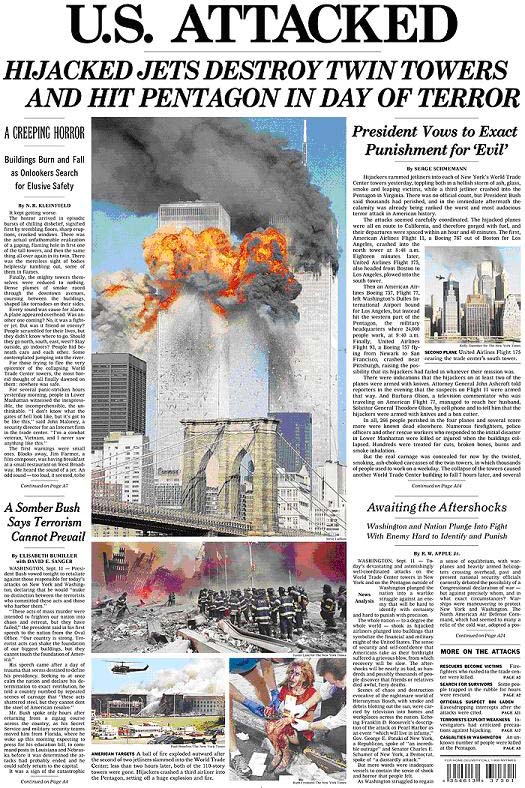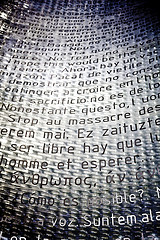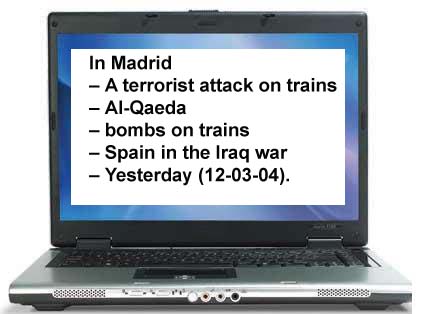Getting information from a newspaper
HEADLINES
Los titulares son como el título que le damos a una noticia. Presentan la noticia misma de una manera clara, directa y muy resumida de manera que en sólo unas pocas palabras conozcamos el suceso o noticia ocurrida. Ya hemos trabajado un poco con los titulares cuando vimos las diferencias entre tabloids y broadsheets y cuando veíamos las secciones de un periódico.
Vamos a seguir trabajando con titulares y de paso desarrollamos más nuestra comprensión escrita.
¿Recuerdas el terrible atentado contra las Torres Gemelas (Twin Towers) de Nueva York?

La característica principal de los titulares es que se elimina todo lo superfluo, quedando sólo lo que aporta información directa; lo que tenemos en los titulares, son pues, frases digamos que incompletas, como se puede ver en estos ejemplos que hemos extraído de la primera página del periódico del 12 de Septiembre de 2001 que acabas de ver:

RESCUERS BECOME VICTIMS.
Firefighters who rushed to the Trade Center were killed.
SEARCH FOR SURVIVORS.
Some people trapped in the rubble for hours were rescued.
OFFICIALS SUSPECT BIN LADEN.
Eavesdropping intercepts after the attacks were cited.
TERRORISTS EXPLOIT WEAKNESS.
Investigators had criticized precautions against hijacking.
CASUALTIES IN WASHINGTON.
An unknown number of people were killed at the Pentagon.
Como se ve claramente en estos titulares, es muy frecuente que cada titular vaya acompañado de un titular secundario o lead que añade más detalles sobre el titular mismo.
Ahora ya hemos visto la manera de presentar las noticias, los titulares; a continuación vamos a hacer una autoevaluación en la que tienes que encontrar el titular de cada noticia. Verás que lo importante va a ser encontrar alguna o algunas palabras que puedas relacionar entre los titulares y el desarrollo de las noticias.
AUTOEVALUACIÓN
En primer lugar, tienes las noticias breves.
1.-
Miles Milton-Barber, a blind British pilot, landed his micro light aircraft in Sydney, Australia, yesterday to complete a record-breaking flight from Britain.
2.-
The Palestinian government has established contact with the kidnappers of a BBC journalist in the Gaza Strip. It was the first time that the Palestinian government had confirmed contact with kidnappers.
3.-
The Countess of Wessex gave birth to the Queen's first male grandchild since Prince Harry. The new addition to the Royal Family is eighth in line for the throne.
4.-
A statue commemorating Soviet soldiers killed during the Second World War was re-erected in a military cemetery three days alter its removal from a square in central Tallin, Estonia, provoked protests by ethnic Russians.
5.-
The Crown Prince, who was present at the delivery, said outside the clinic in northern Madrid where Sofia was born that both mother and daughter were doing well.
"We are very happy," he said. "I truly didn't know how I was going to react."
Y ahora los titulares que tienes que asignar a las noticias:
a.- Second daughter for heir to Spanish throne
b.- Statue re-erected
c.- Happy landing
d.- Contact made with BBC man's kidnappers
e.- Countess gives birth
1.-
2.-
3.-
4.-
5.-
THE SIX W's
¿Qué significa esto de las seis W?
Ahora te lo explicamos.
Cuando decimos que estamos leyendo el periódico en realidad lo que hacemos es leer los titulares y sólo cuando hay un titular que nos llama la atención, nos provoca curiosidad o sencillamente trata de algún asunto que nos interesa, sólo entonces es cuando pasamos a leer el contenido de la noticia en su totalidad.
¿Qué son las seis W? Pues se refieren a los pronombres interrogativos WHAT, WHO, WHERE, WHEN, WHY, y HOW. En otras palabras, cuando el periodista redacta la noticia ha de proporcionar información de modo que se respondan las que se llaman "las preguntas del periodista":
- What? - ¿Qué ha sucedido? (Los hechos)
- Who? - ¿Quién/ quienes son los protagonistas de la noticia? (Los sujetos)
- Where? - ¿Dónde ha ocurrido? (El lugar)
- When? - ¿Cuándo? (El tiempo)
- Why? - ¿Por qué ha ocurrido? (La causa)
- How? - ¿Cómo? (El modo)
AUTOEVALUACIÓN
Ahora vamos a hacer un ejercicio para reconocer las seis W en una noticia. Te vamos a poner la tarea lo más fácil posible ya que vamos a responder a las seis W en una crónica periodística.
Desgraciadamente España sufrió un dramático atentado terrorista el 11 de marzo de 2004 en Madrid. Durante varios días, cientos de periodistas, tanto españoles como extrajeros, acudieron a ruedas de prensa para ser informados de lo ocurrido. El corresponsal (correspondent) de un periódico británico elaboró la siguiente crónica a partir de los apuntes tomados en una rueda de prensa.
 |
After yesterday's bomb attacks in Madrid, the Spanish public are to join together in three days of national mourning. The bombs on the trains killed nearly 200 people. In newspaper articles, radio and television announcements and even mobile phone messages, Spaniards are encouraging one another to take part in a planned mass demonstration this evening to protest against terror and yesterday's bloody attacks. Across Spain, people held candlelit vigils throughout the night, expressing their sympathy with the numerous victims. The Spanish government has called for three days of national mourning. Meanwhile the official investigation and public speculation into who was behind the atrocity continues. Intelligence officials here say there's conflicting evidence, pointing to an Islamist organisation linked to al-Qaeda, because the involvement of Spain in the Iraq war. |
| |
Durante la rueda de prensa (press meeting), el corresponsal fue tomando apuntes en su portátil. A partir de estas notas rápidamente redactó la crónica que acabas de leer y sin perder tiempo la envión por email a la redacción de su periódico en Londres utilizando la conexión de internet móvil de su ordenador. Mira los apuntes más relevantes de la noticia.

1.- What?
2.- Who?
3.- Where?
4.- When?
5.- Why?
6.- How?
Practiquemos un poco más con las seis W (al fin y al cabo lo que estamos haciendo es captar la información más relevante de un texto).
 |
Paris.- By correspondent Susan Jacobs Yesterday, at the National Assembly, the President of the French Republic presented the Government decisions to solve the country's economic situation. The most alarming problems are the fall of industrial production and private consumerism. The reasons for this dramatic fall is the difficulty to find loans from banks. In order to solve these problems, the Government will lend 75,000 millions euros to banks so that companies and individuals can have an easy and fast access to loans. |
Rellena los huecos de manera que queden respondidas las seis W:
| What? | Government's to the country's were presented. |
|
Who? |
The of the Republic |
| Where? | At the
, in
|
| When? | |
| Why? | Dramatic in industrial and provoked by to find from banks. |
| How? | The will euros to so that companies and individuals can get and . |
Si te interesa el mundo de los periódicos, visita la siguiente web. En ella, encontrarás la posibilidad de ver las portadas de 530 periódicos del mundo entero, y además tiene un archivo con el que se puede seleccionar una fecha señalada por algún acontecimiento importante y ver las portadas de ese día: